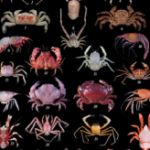
Vulcanoctopus hydrothermalis (Mollusca: Cephalopoda: Octipodidae)
Octopus are one the most fascinating and intelligent of the invertebrates. Yet, little is known about their role in the deep sea, even less is known from methane seeps of hydrothermal vents! In fact, only one species has been described from a hydrothermal vent to date, the “hot water volcano octopus”.
Description Vulcanoctopus hydrothermalis (1) is a benthic octopus that so far measures up to only 52mm in mantle length (7). Its eyes are greatly reduced in function (i.e. no visible iris) and body lacks pigment and chromatophores, resulting in a translucent skin. There are two rows of suckers on its arms, with one arm hectocotylized (see Reproduction below).

Physiology Rocha et al. (6) noted there was no response of the octopus to light from the submersible, suggesting the lack of function in the eye. Nothing else is known about their physiology.
Nutrition Little is known about their nutrition. Rocha et al. (6) observed V. hydrothermalis using “tactile feeding” by using its arms to detect prey, in this case the crab Bythograea thermydron. However, the attack was withdrawn. In another paper, V. hydrothermalis was observed feeding from amphipod swarms of Halice hesmonectes (7), which can form dense swarms of up to 1000 individuals/litre near vent openings (3). V. hydrothermalis engulfs the swarm uses is webs to trap prey (6, 7). Gut contents from this feeding event confirmed the presence of several amphipods in the gut tract and stomach (7).

Reproduction Curiously, it seems from the literature that only males have been captured and observed in nature. Gonzalez et al. (2) notes that some octopod species have spatial segregation of the sexes and this may be the reason females hav yet to be captured. Males are easily spotted by the presence of a hectocotylus, a specialized extended tentacle used to store spermatophores. Spermatophores are little packets of male gametes called spermatozoa. In V. hydrothermalis, the male deposits its spermatophore in the mantle cavity of the female. This has actually been observed in V. hydrothermalis, except that is was depositing its spermatophore inside the mantle cavity of another male… from a different speciesof octopus (5)! Mature males have an average of 47 spermatophores in dissected specimens (2).
Ecology Vulcanoctopus hydrothermalis appears to be closely associated with tubeworm (Riftia pachyptila) aggregations and serpulid “clumps” (7). The few instances they have been observed they have been seen in groups up to 5-12 (6, 7). V. hydrothermalis specimens also tend to be infected with a parasitic copepod, Genesis vulcanoctopusi (4). Their group behaviour might contribute to the spread of the parasite (7). When threatened, this octopus will try to hide among the clumps of R. pachyptila. Its secondary response is to take-off by pulsating its arms toward the mantle cavity in a movement somewhat akin to a jelly medusa (6). There was never any cryptic color change as seen in shallow water octopodids (6).
Biogeography These octopus have been only been described from depths of 2600-2650m on the East Pacific Rise at 13 degrees north (1, 6, 7).
Futher Reading:
1. González, A. F., Á. Guerra, S. Pascual, and P. Briand. 1998. Vulcanoctopus hydrothermalis gen. et sp. nov. (Mollusca, Cephalopoda): an octopod from a deep-sea hydrothermal vent site. Cahiers Biologie Marine 39:169-184.
2. González, A. F., Á. Guerra, F. Rocha, and P. Briand. 2002. Morphological variation in males of Vulcanoctopus hydrothermalis (Mollusca: Cephalopoda). Bulletin of Marine Science 71:289-298.
3. Kaartvedt, S., C. L. Van Dover, L. S. Mullineaux, P. H. Wiebe, and S. M. Bollens. 1994. Amphipods on a deep-sea treadmill. Deep-Sea Research I 41:179-195.
4. López-González, P. J., K. Bresciani, R. Huys, A. F. González, Á. Guerra, and S. Pascual. 2000. Description of Genesis vulcanoctopusi gen. et. sp. nov. (Copepoda: Tisbidae) parasitic on a hydrothermal vent octopod and a reinterpretation of the life cycle of cholidyinid parpacticoids. Cahiers Biologie Marine 41:241-253.
5. Lutz, R. A., and J. R. Voight. 1994. Close encounter in the deep. Nature 371:563.
6. Rocha, F., Á. F. González, M. Segonzac, and Á. Guerra. 2002. Behavioural observations of the cephalopod Vulcanoctopus hydrothermalis. Cahiers Biologie Marine 43:299-302.
7. Voight, J. R. 2005. Hydrothermal vent octopuses of Vulcanoctopus hydrothermalis, feed on bathypelagic amphipods of Halice hesmonectes. Journal of the Marine Biological Association of the UK 85:985-988.






Vulcanoctopus looks like he got flattened by a tow sled
I would like to note for the record that the two pictures of Vulcanoctopus are courtesy of Peter Batson, please check out his deep-sea photography work (and buy Deep New Zealand!) at exploretheabyss.com and deepseaphotography.com
The in situ picture background is courtesy of Janet Voight and The Field Museum, modified by me.
Thanks!